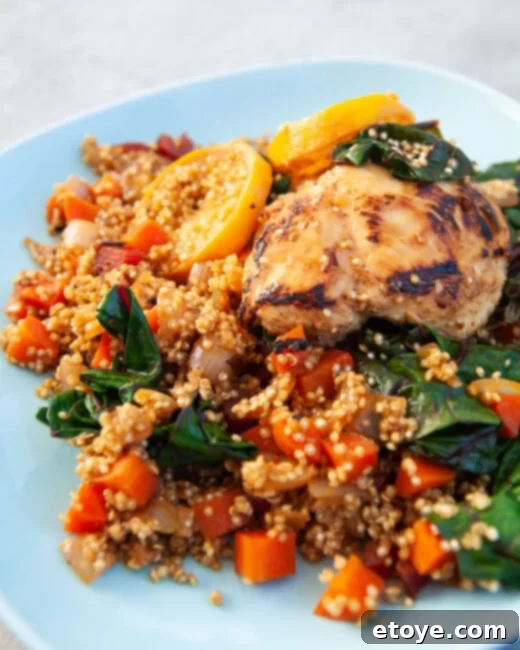Did you know that a staggering number of individuals globally face the challenges of Alzheimer’s disease and related dementias? Current statistics reveal that approximately 5.8 million Americans and over 55 million people worldwide are living with these conditions. These numbers are projected to rise significantly in the coming decades, underscoring the urgent need for effective prevention strategies. Fortunately, research offers a beacon of hope: adopting the MIND diet has been shown to dramatically reduce the risk of developing Alzheimer’s disease and slow cognitive decline by an impressive margin of up to 53%.
The MIND diet is a nutritional plan specifically designed to promote brain health and combat neurodegenerative diseases. It combines elements of two well-established healthy eating patterns: the Mediterranean diet and the DASH (Dietary Approaches to Stop Hypertension) diet. The emphasis is on plant-based foods, lean proteins, and healthy fats, while limiting foods that can negatively impact cognitive function. Incorporating brain-boosting meals into your routine is not just about physical well-being; it’s a vital investment in your long-term cognitive vitality. This article explores a delicious and easy-to-prepare recipe that aligns perfectly with the principles of the MIND diet: a wholesome Vegetable Quinoa Pilaf with Honey Mustard Chicken. It’s not only packed with flavor but also brimming with nutrients essential for a sharp mind.
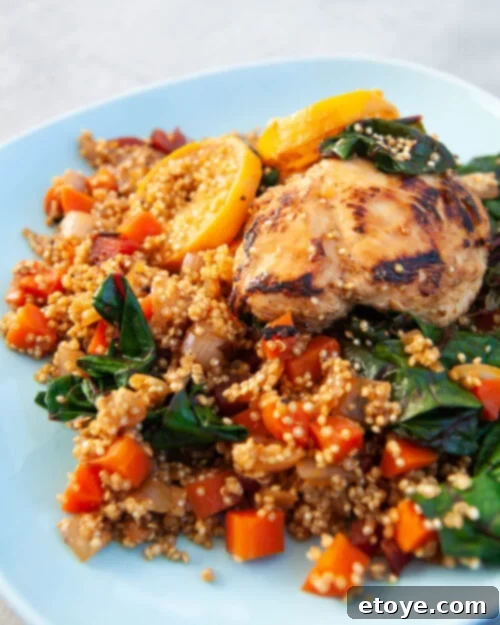
This Vegetable Quinoa Pilaf with Honey Mustard Chicken recipe, previously featured on The List, is a prime example of how delicious meals can simultaneously be incredibly beneficial for your brain. It skillfully incorporates key ingredients recommended by the MIND diet known for their ability to boost cognitive function and help prevent dementia. The star components include nutrient-dense quinoa, lean chicken breast, vibrant swiss chard, and other dark, leafy greens. Each ingredient plays a crucial role in providing your brain with the fuel it needs to thrive.
Understanding the MIND Diet for Optimal Brain Health
The MIND diet, a hybrid of the Mediterranean and DASH diets, specifically targets brain health. It focuses on foods with scientific evidence of their positive impact on cognitive function, emphasizing nutrients that can protect against Alzheimer’s disease and other forms of dementia. This dietary pattern prioritizes certain food groups while limiting others, creating a powerful shield for your brain. By adhering to the MIND diet, you’re not just eating healthy; you’re strategically fueling your brain for longevity.
Key Principles of the MIND Diet: What to Eat More Of
- Green Leafy Vegetables: Aim for at least six servings per week. Spinach, kale, collard greens, and swiss chard are rich in vitamins K, A, C, folate, beta-carotene, and lutein, all crucial for cognitive function.
- Other Vegetables: Consume at least one serving daily, beyond leafy greens. A variety of colorful vegetables provides a broad spectrum of antioxidants and nutrients.
- Berries: Strive for at least two servings per week. Blueberries, strawberries, and raspberries are brain superstars, packed with flavonoids that can improve memory.
- Nuts: Incorporate five or more servings weekly. Almonds, walnuts, and pecans are excellent sources of healthy fats, fiber, and vitamin E, which protects brain cells.
- Whole Grains: Include at least three servings daily. Oats, quinoa, brown rice, and whole-wheat pasta provide steady energy for the brain and are rich in B vitamins.
- Fish: Eat fish, especially fatty fish like salmon, mackerel, and tuna, at least once a week. They are high in omega-3 fatty acids, vital for brain structure and function.
- Beans: Include beans or legumes in at least four meals per week. They are a great source of fiber, protein, and B vitamins, supporting overall brain health.
- Poultry: Consume chicken or turkey at least twice a week. Opt for lean cuts to ensure you’re getting protein without excessive saturated fat.
- Olive Oil: Use olive oil as your primary cooking oil. Its monounsaturated fats are beneficial for cardiovascular health, which directly impacts brain health.
Foods to Limit or Avoid on the MIND Diet:
- Red Meat: Limit to less than four servings per week.
- Butter and Margarine: Keep intake below one tablespoon daily.
- Cheese: Restrict to less than one serving per week.
- Pastries and Sweets: Limit to fewer than five servings per week.
- Fried or Fast Food: Consume less than one serving per week.
By following these guidelines, the MIND diet helps reduce inflammation, oxidative stress, and the buildup of beta-amyloid plaques—all factors implicated in the development of Alzheimer’s disease. It’s a holistic approach to nutrition that recognizes the intricate connection between what we eat and how our brains function.
Why This Vegetable Quinoa Pilaf with Honey Mustard Chicken Recipe is Perfect for Your Brain
This particular recipe isn’t just delicious; it’s a meticulously crafted meal that embodies the core principles of the MIND diet. Every component is chosen for its specific benefits, contributing to a meal that supports cognitive function and overall well-being. Here’s why it stands out:
- Effortless Overnight Honey Mustard Marinade: The marinade is simple to prepare, requiring minimal effort. By allowing the chicken to marinate overnight, the flavors deeply penetrate the meat, ensuring a tender, juicy, and incredibly flavorful result. This process also ensures the chicken breast, a lean protein, remains moist during cooking, enhancing the overall dining experience.
- Bright Flavors from Lemon Zest and Slices: The addition of fresh lemon zest and slices not only brightens the dish with a zesty aroma but also infuses it with Vitamin C and powerful antioxidants. These elements are crucial for fighting free radicals and reducing oxidative stress in the brain, contributing to cognitive protection. The citrus adds a refreshing counterpoint to the richness of the chicken and vegetables.
- A Touch of Sweetness from Honey: Honey provides a natural, healthier alternative to refined sugars, adding a delightful sweet kick that balances the savory and tangy notes of the dish. While moderation is key, natural sweeteners like honey can contribute to flavor complexity without undermining the diet’s health goals.
Key Brain-Boosting Ingredients in This Recipe:
- Quinoa: A complete protein and a superb whole grain, quinoa provides sustained energy for brain function. It’s rich in fiber, supporting gut health which is increasingly linked to brain health, and contains essential amino acids vital for neurotransmitter production.
- Chicken: As a lean protein, chicken supplies the building blocks for brain cells and neurotransmitters. It’s also a good source of B vitamins, particularly B6 and B12, which are essential for nerve function and preventing cognitive decline.
- Swiss Chard & Dark Leafy Greens: These vibrant greens are superstars of the MIND diet. They are loaded with vitamins K, A, and C, as well as folate and a host of antioxidants like lutein and zeaxanthin. These nutrients are critical for reducing inflammation, protecting brain cells from damage, and supporting memory and learning.
- Olive Oil: Used for both the marinade and sautéing, extra virgin olive oil is a cornerstone of the Mediterranean and MIND diets. It provides healthy monounsaturated fats that are crucial for maintaining cell membrane integrity in the brain and have anti-inflammatory properties.
- Garlic & Red Pepper Flakes: Beyond their flavor-enhancing qualities, garlic contains compounds with anti-inflammatory and antioxidant effects, while red pepper flakes offer capsaicin, which may have neuroprotective benefits.
By combining these powerful ingredients, this Vegetable Quinoa Pilaf with Honey Mustard Chicken becomes more than just a meal; it’s a strategic culinary choice for enhancing your brain health and embracing a lifestyle that supports cognitive longevity.
Ingredients for this Brain-Healthy Vegetable Quinoa Pilaf with Honey Mustard Chicken Recipe:
Gathering fresh, high-quality ingredients is the first step to creating this nourishing meal. Here’s what you’ll need:
- 2 tablespoons olive oil, divided
- 1 tablespoon honey
- 1 tablespoon mustard
- 2 cloves garlic, minced
- ½ teaspoon crushed red pepper flakes
- 1 teaspoon kosher or sea salt
- Freshly ground black pepper, to taste
- 4 skin-on chicken breasts (boneless, skinless can also be used, adjust cooking time)
- 1 small onion, diced
- 1 large carrot, diced
- 1 bunch swiss chard, stems chopped and leaves torn
- 1 lemon, zested and sliced into ½” slices
- 1 cup chicken broth (low sodium recommended)
- 1 cup quinoa, rinsed

How to Make This Vegetable Quinoa Pilaf with Honey Mustard Chicken: A Step-by-Step Guide
Creating this delicious and brain-boosting meal is straightforward. Follow these steps for a perfectly cooked dish that’s rich in flavor and nutrients.
- Prepare the Chicken Marinade: In a large bowl or a sealable freezer bag, combine 1 tablespoon of the olive oil, honey, mustard, minced garlic, crushed red pepper flakes, kosher or sea salt, and a generous amount of freshly ground black pepper. Whisk these ingredients together until well combined. Add the chicken breasts to the marinade, ensuring each piece is thoroughly coated. Cover the bowl or seal the bag and refrigerate overnight. This extended marination time allows the flavors to deeply infuse the chicken, making it exceptionally tender and delicious.
- Sear the Chicken to Perfection: The next day, remove the chicken from the refrigerator at least 30 minutes before cooking to bring it closer to room temperature. Heat a large sauté pan or oven-safe skillet over medium-high heat. Add the remaining 1 tablespoon of olive oil. Once the oil is shimmering but not smoking, carefully place the marinated chicken breasts, skin-side down, into the hot pan. Cook for 3-4 minutes, allowing the skin to become beautifully golden brown and crispy. Flip the chicken and cook the other side for another 3 minutes. This searing locks in juices and builds flavor. Transfer the seared chicken to a plate and set it aside; it will finish cooking with the quinoa and vegetables later.
- Sauté the Flavorful Vegetables: Using the same pan, which should still have residual oil and flavorful browned bits (fond) from the chicken, reduce the heat to medium. Add the diced onion, diced carrot, swiss chard stems (reserving the leaves for later), and the lemon zest. Sauté these vegetables for 5-6 minutes, using your spatula to scrape up any browned bits from the bottom of the pan – these bits are packed with flavor! Continue cooking until the vegetables have softened and become aromatic.
- Cook the Quinoa and Complete the Dish: Pour in the chicken broth and stir in the rinsed quinoa, ensuring it’s evenly distributed. Bring the liquid to a simmer, then cook, uncovered, for 5 minutes. Reduce the heat to low. Carefully arrange the lemon slices on top of the simmering quinoa. Next, layer the swiss chard leaves over the lemon slices and quinoa. Finally, place the seared chicken breasts back into the pan, resting them on top of the swiss chard leaves. Cover the pan tightly and continue to cook for 10 minutes, or until the quinoa is fully cooked and has absorbed most of the liquid, and the chicken is cooked through (internal temperature should reach 165°F). Remove the pan from the heat and let it rest, covered, for an additional 5 minutes. This crucial resting period allows the quinoa to absorb any remaining liquid, resulting in a perfectly fluffy texture, and ensures the flavors meld beautifully. Serve hot and enjoy your brain-boosting meal!



Frequently Asked Questions About This Recipe & The MIND Diet
Here are some common questions about this recipe and general aspects of the MIND diet to help you get the most out of your healthy eating journey.
How do I know when the chicken is fully cooked?
For food safety, always ensure chicken reaches an internal temperature of at least 165°F (74°C). The best way to check this is by inserting a meat thermometer into the thickest part of the chicken breast without touching the bone. If you don’t have a thermometer, cut into the thickest part; the juices should run clear, and the meat should be opaque throughout.
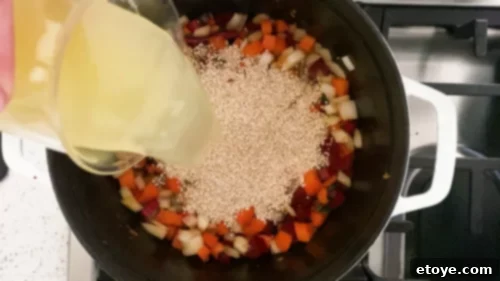
What are the benefits of quinoa for brain health?
Quinoa is often lauded as a “superfood” due to its impressive nutritional profile, making it excellent for overall health and specifically for your brain. It’s a complete protein, meaning it contains all nine essential amino acids necessary for body and brain function. Quinoa is rich in fiber, which aids digestion and helps regulate blood sugar, providing a steady energy supply to the brain. Furthermore, it’s packed with antioxidants and anti-inflammatory plant compounds that protect brain cells from damage. As a naturally gluten-free grain, it’s suitable for those with gluten sensitivities, and its high mineral content, including magnesium and iron, supports nerve transmission and oxygen transport to the brain.
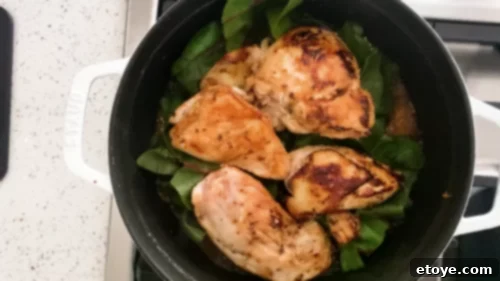
Can I substitute ingredients in this recipe?
Absolutely! The MIND diet encourages variety. For the chicken, you could use boneless, skinless thighs or even a firm white fish like cod or halibut, adjusting cooking times accordingly. If swiss chard isn’t available, spinach, kale, or collard greens make excellent substitutes for the leafy greens. Feel free to add other MIND-friendly vegetables like bell peppers, zucchini, or mushrooms during the sautéing step to boost nutrient content. Just remember to maintain the balance of whole grains, lean protein, and plenty of vegetables.
How should I store leftovers?
Leftovers of this pilaf can be stored in an airtight container in the refrigerator for up to 3-4 days. It reheats well in a microwave or on the stovetop with a splash of chicken broth or water to maintain moisture. This makes it an excellent option for meal prepping healthy lunches or quick dinners throughout the week.
Is this recipe gluten-free?
Yes, as written, this recipe is naturally gluten-free, thanks to quinoa being a gluten-free grain. Always double-check ingredient labels, especially for chicken broth, to ensure they don’t contain hidden gluten if you have a severe allergy or sensitivity.
What are other practical tips for following the MIND diet?
Beyond specific recipes, integrate these habits: choose whole grains over refined grains, snack on nuts and berries, prioritize fish over red meat, and cook with olive oil. Drink plenty of water. Consistency is key; small, consistent dietary changes accumulate significant brain health benefits over time. Think of the MIND diet as a lifestyle shift, not just a temporary diet.
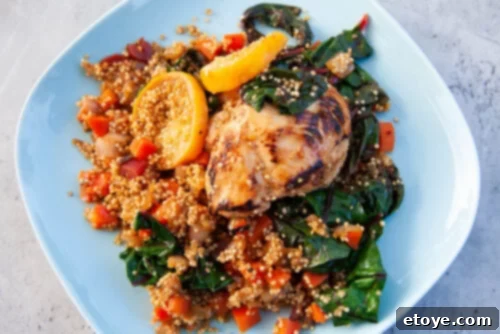
Discover More Delicious MIND Diet Recipes
The journey to enhanced brain health is both rewarding and flavorful. Explore these other fantastic MIND diet-friendly recipes to keep your meals exciting and your brain nourished:
- Seared Salmon Salad with Baked Crispy Chickpeas & Fresh Strawberry Vinaigrette Recipe
- Overnight Oats with Berries & Nuts Recipe
Vegetable Quinoa Pilaf with Honey Mustard Chicken Recipe
A healthy dinner recipe inspired by the suggested ingredients of the MIND Diet, designed to boost brain function and promote cognitive health.
Ingredients
- 2 tbsp olive oil, divided
- 1 tbsp honey
- 1 tbsp mustard
- 2 cloves garlic, minced
- ½ tsp crushed red pepper flakes
- 1 tsp kosher or sea salt
- freshly ground black pepper, to taste
- 4 skin-on chicken breasts
- 1 small onion, diced
- 1 large carrot, diced
- 1 bunch swiss chard, stems chopped and leaves torn
- 1 lemon, zested and sliced into ½” slices
- 1 cup chicken broth
- 1 cup quinoa, rinsed
Instructions
- Marinate the chicken: In a large bowl or freezer bag, mix together 1 tablespoon of the olive oil, honey, mustard, garlic, red pepper flakes, salt and pepper. Add in the chicken breasts to marinate overnight in the refrigerator.
- Sear the chicken: Heat a large sauté pan over medium-high heat. Swirl in 1 tablespoon of olive oil. When shimmering, add in the chicken breast, skin-side down. Cook for 3-4 minutes, until skin is nicely seared. Flip the chicken and cook the other side for 3 minutes. Transfer to a plate and set aside to finish cooking later.
- Cook the vegetables: In the same pan (there should still be some oil), on medium heat, add in the onion, carrot, swiss chard stems (not leaves), and the lemon zest. Use your spatula to scrape up the bits in the pan. Sauté for 5-6 minutes, until the vegetables are softened.
- Cook the quinoa: Pour in the chicken broth and stir in the quinoa. When simmering, cook for 5 minutes, uncovered. Turn the heat to low and lay the lemon slices in the pan. Lay the swiss chard leaves on top of the quinoa. Transfer the chicken breasts back to the pan, on top of the swiss chard leaves. Cover and cook for 10 minutes until the quinoa is cooked through. Let rest for 5 minutes to allow the quinoa to absorb the remaining liquid.
Nutrition
Carbohydrates: 42 g
Protein: 32 g
Fat: 21 g
Saturated Fat: 4 g
Polyunsaturated Fat: 5 g
Monounsaturated Fat: 10 g
Trans Fat: 1 g
Cholesterol: 72 mg
Sodium: 1089 mg
Potassium: 964 mg
Fiber: 6 g
Sugar: 8 g
Vitamin A: 7319 IU
Vitamin C: 44 mg
Calcium: 99 mg
Iron: 5 mg
